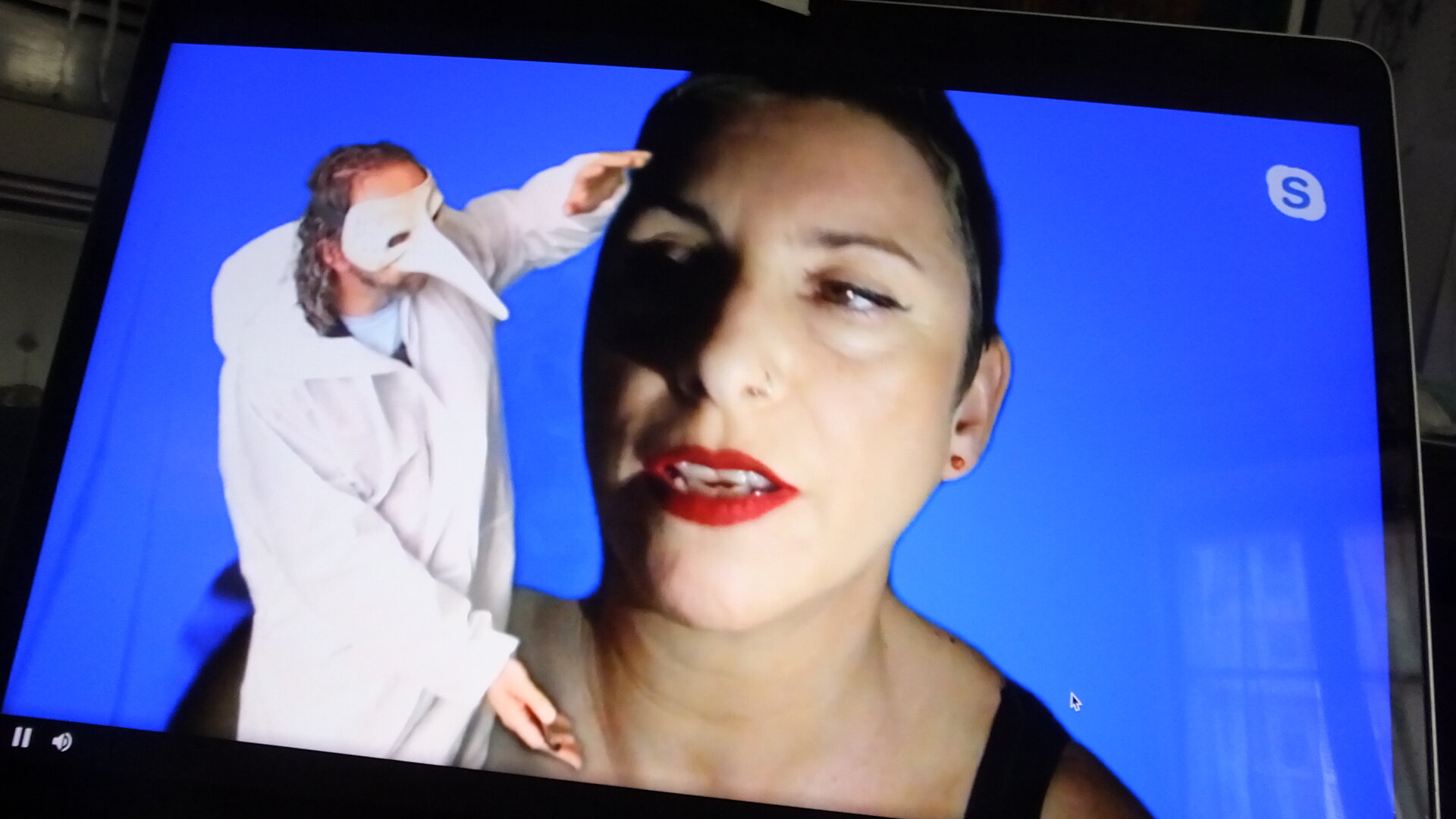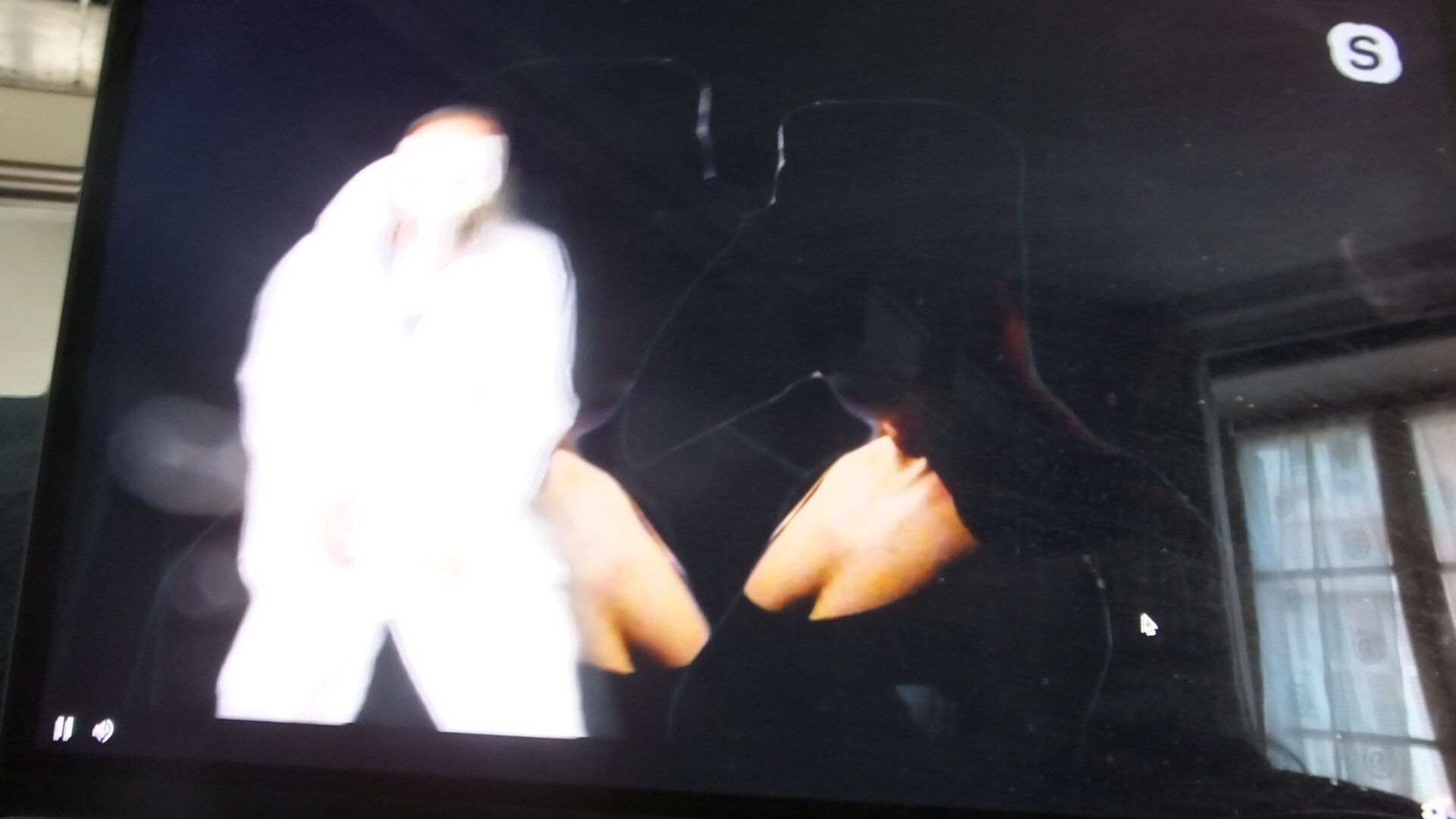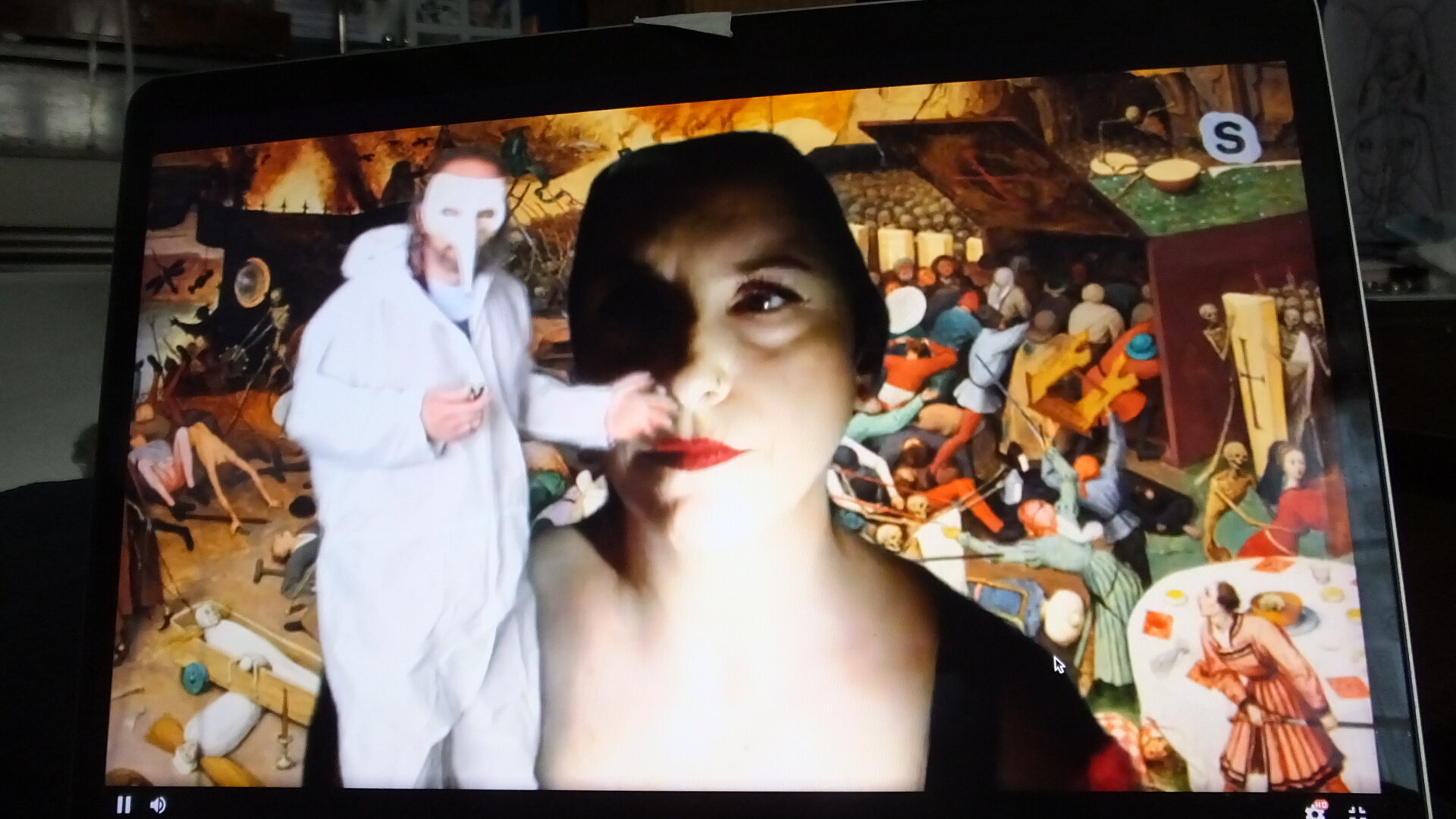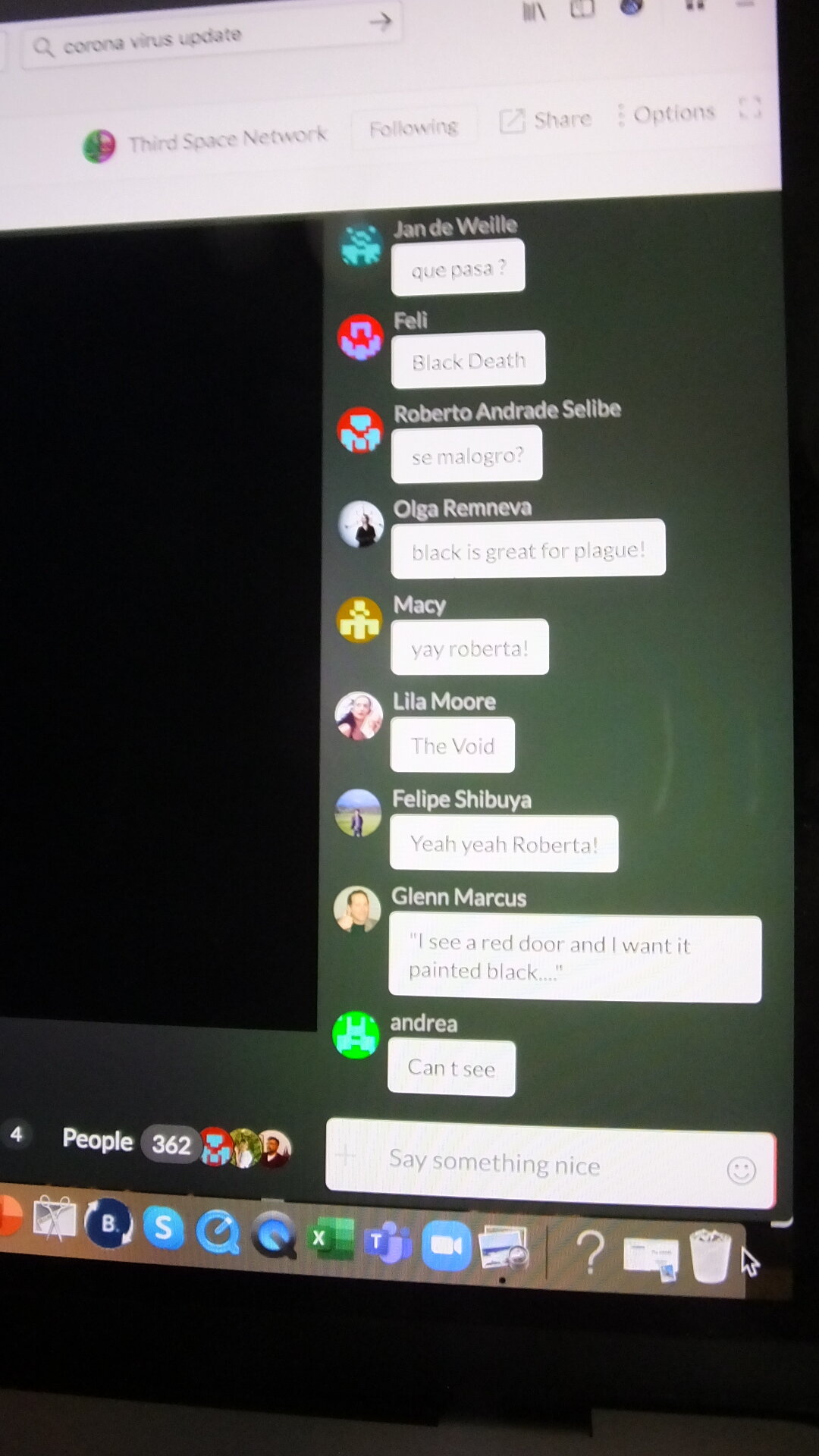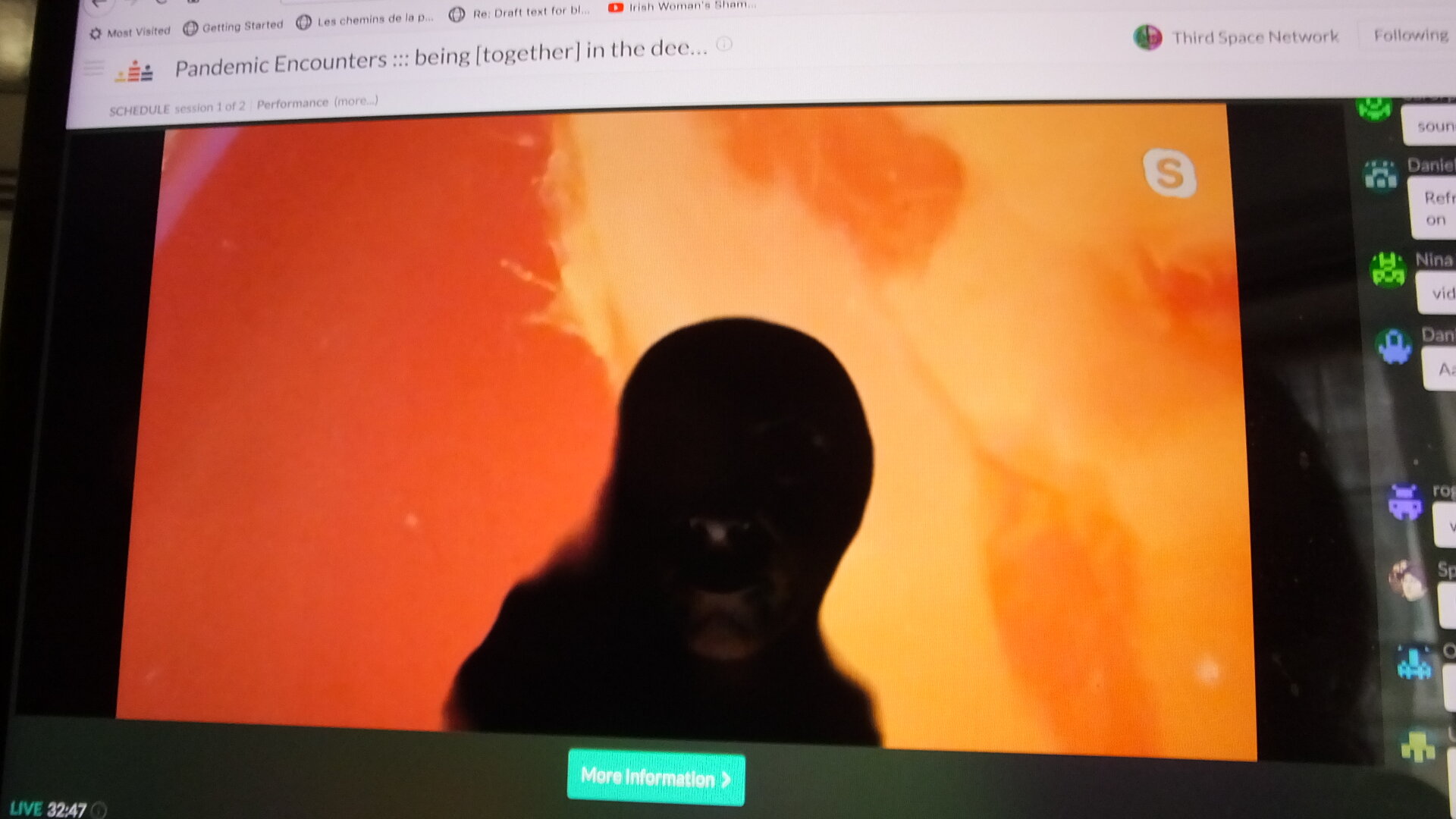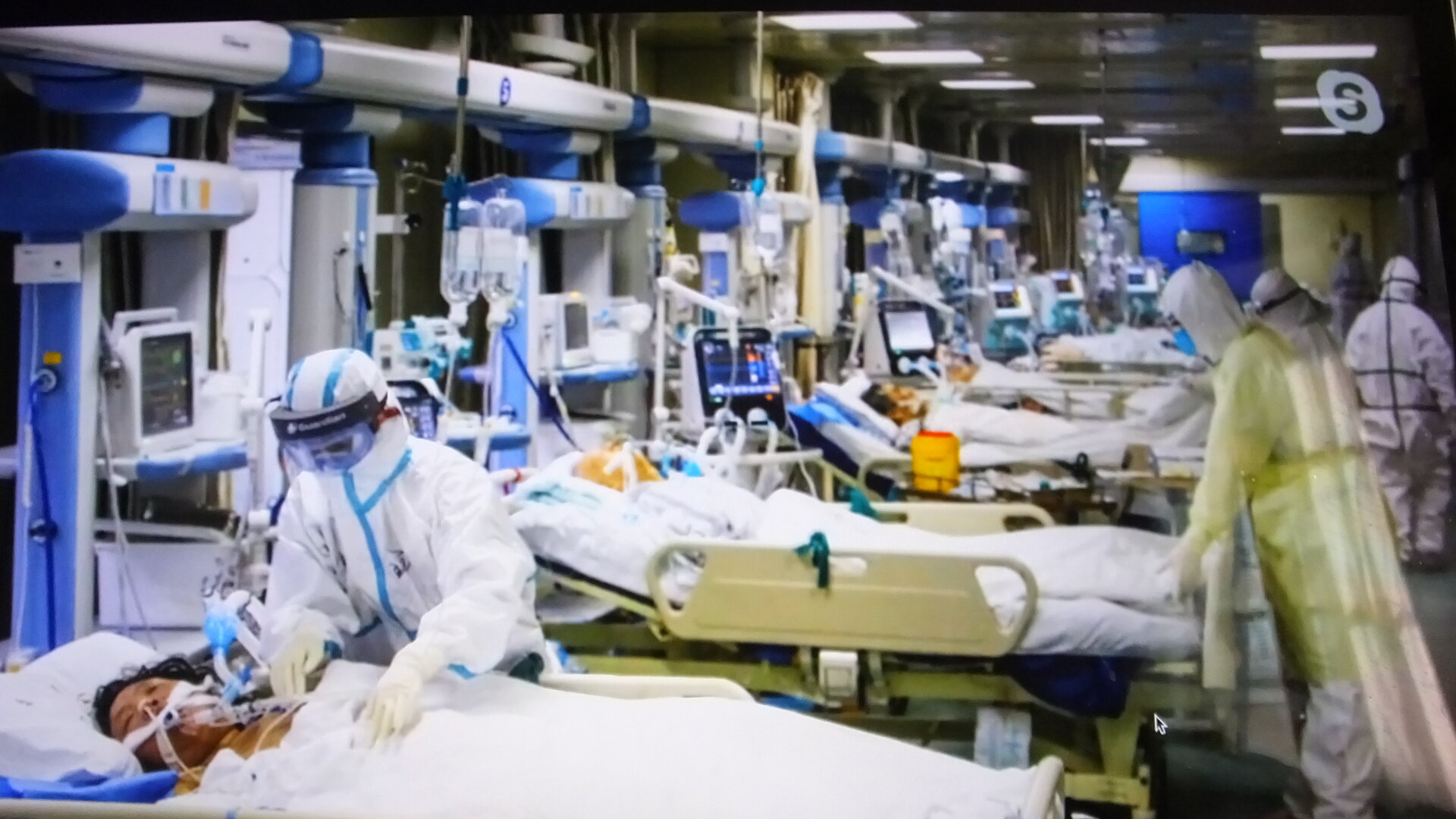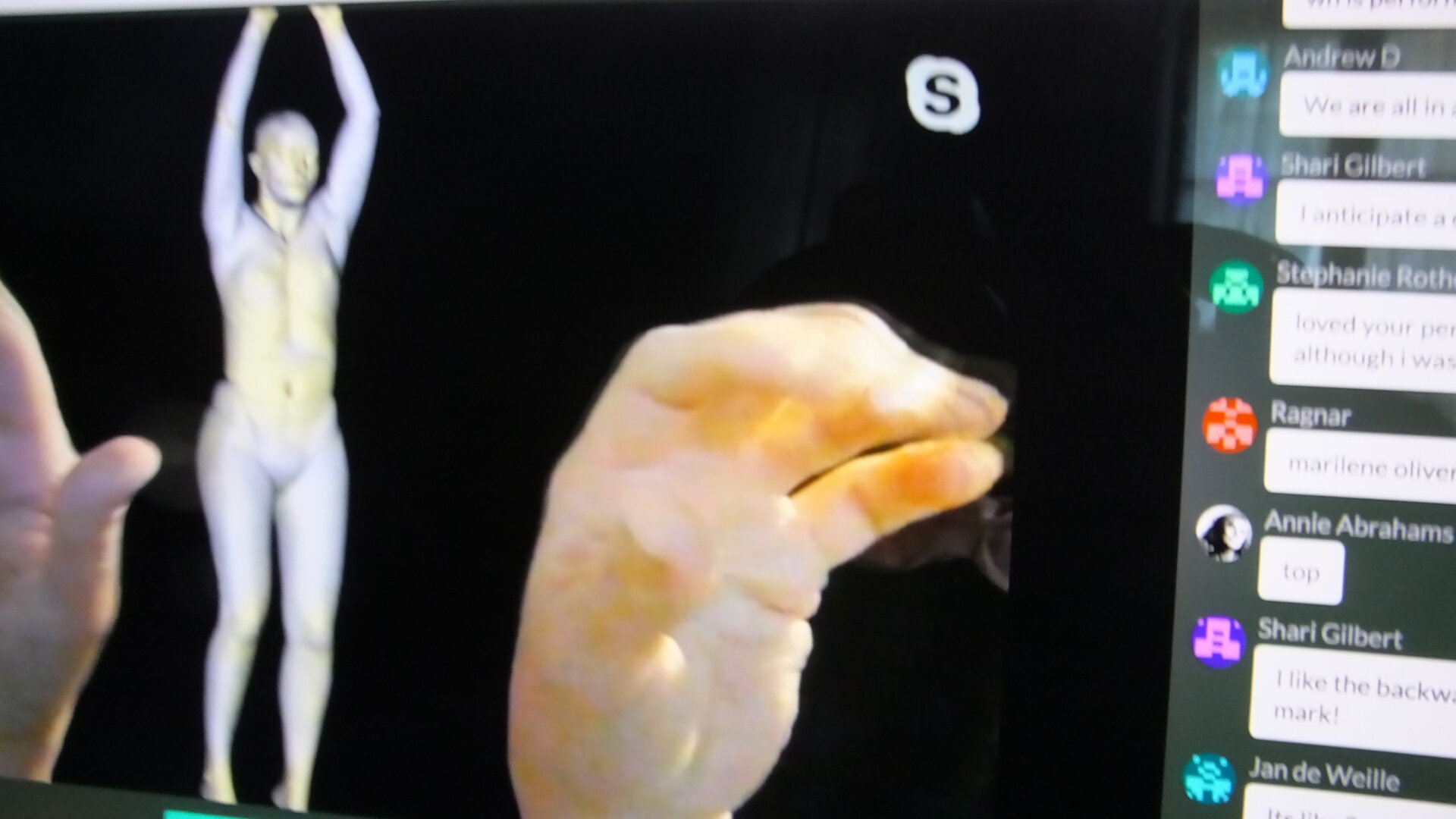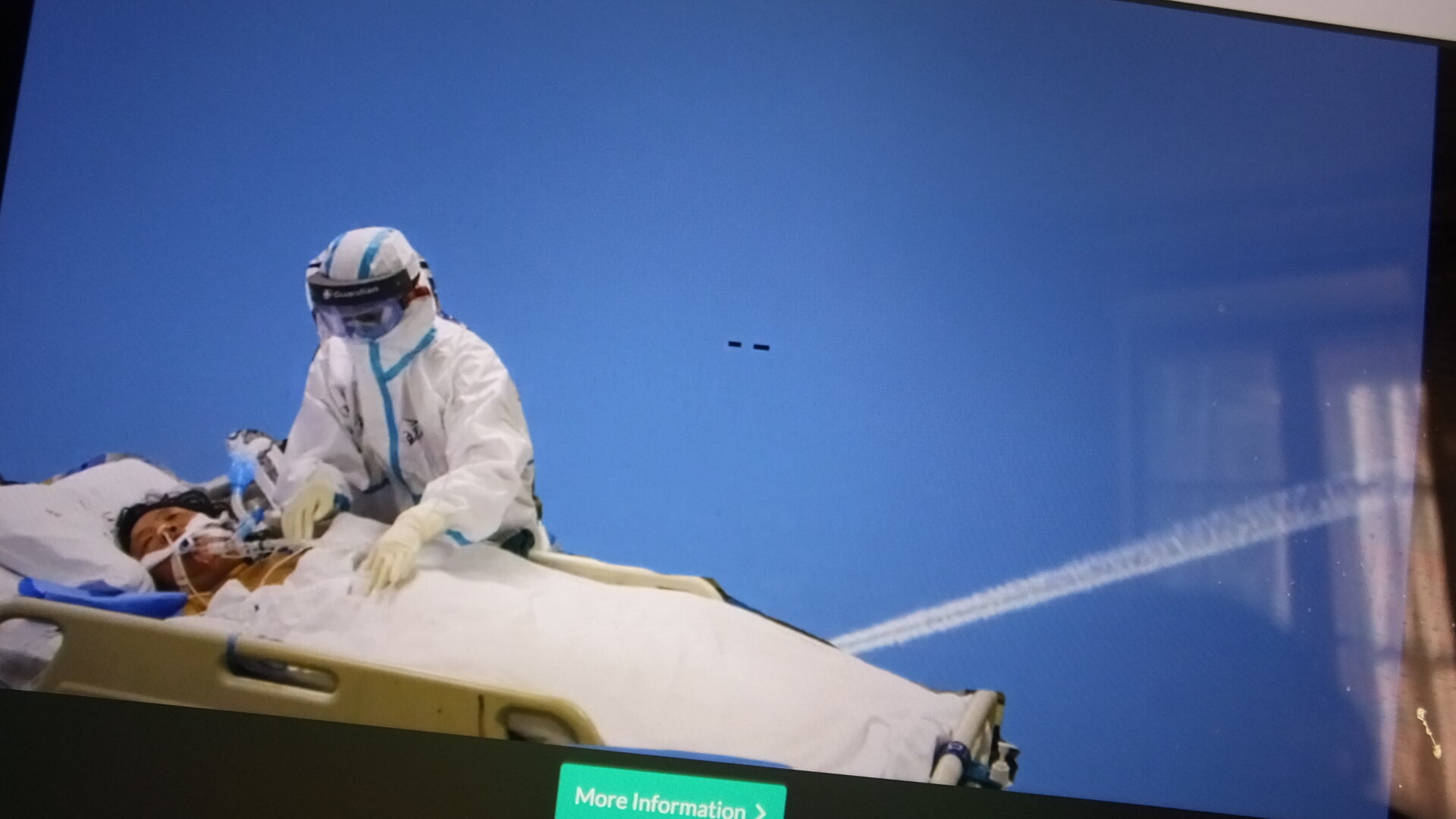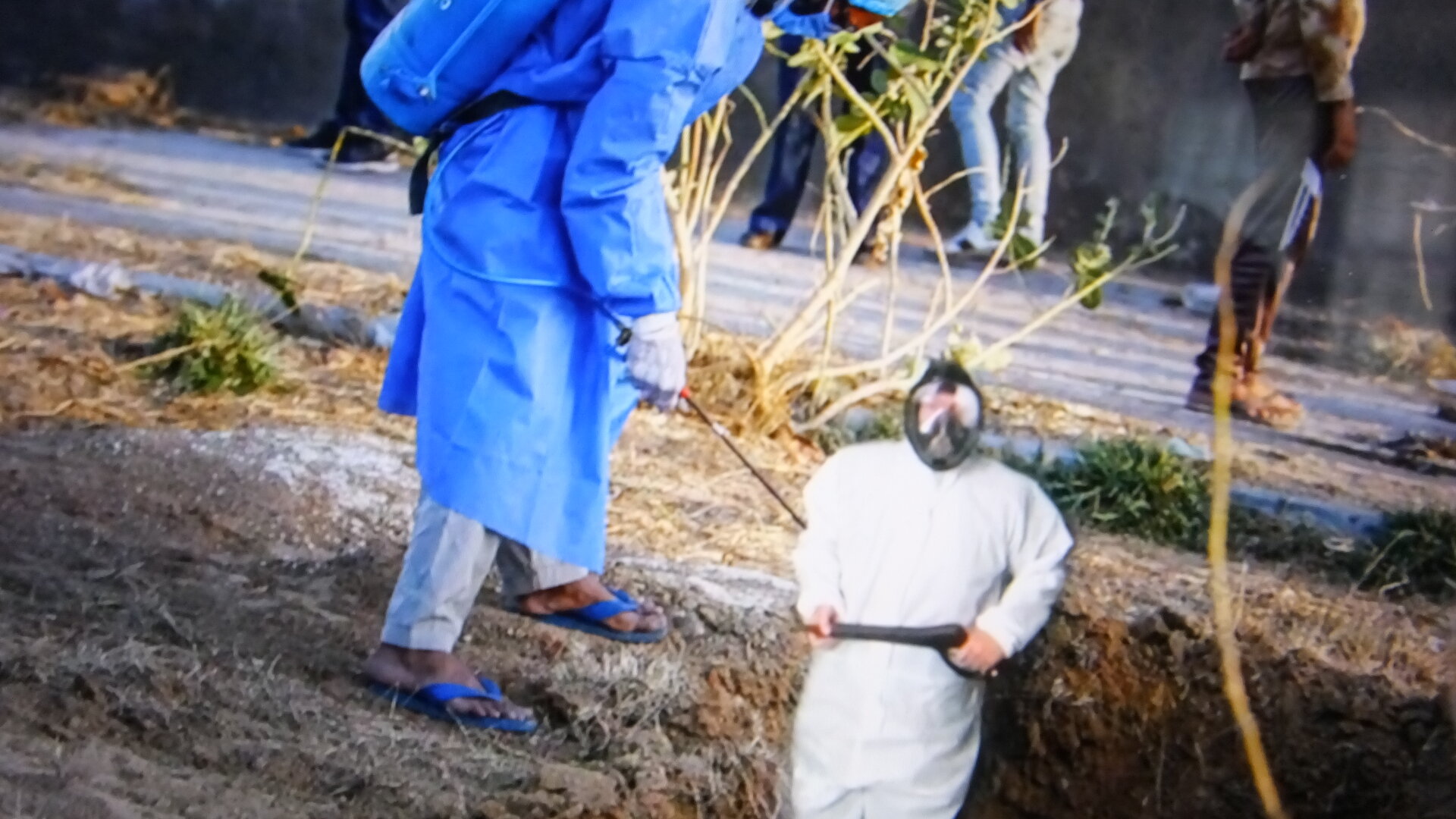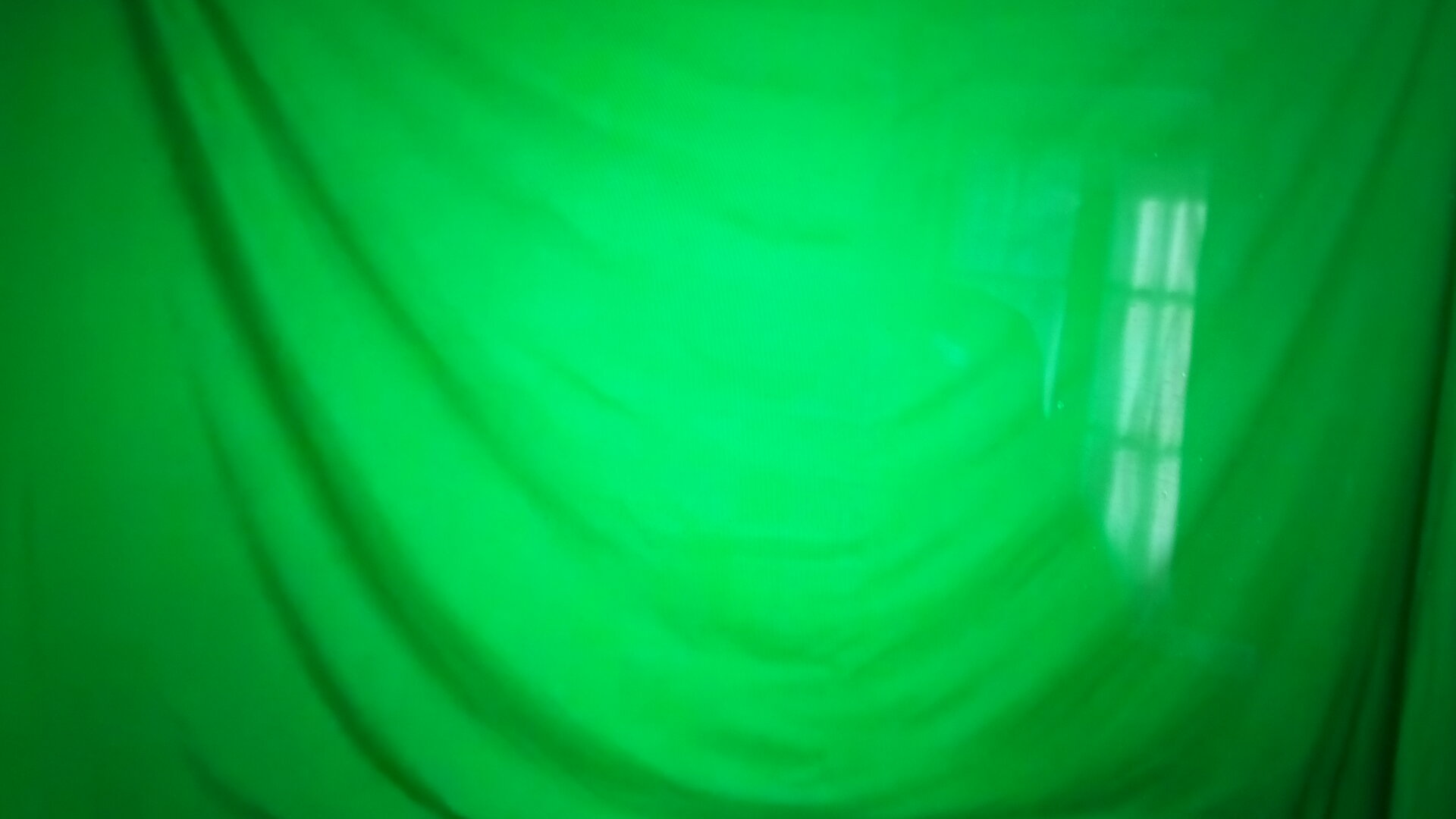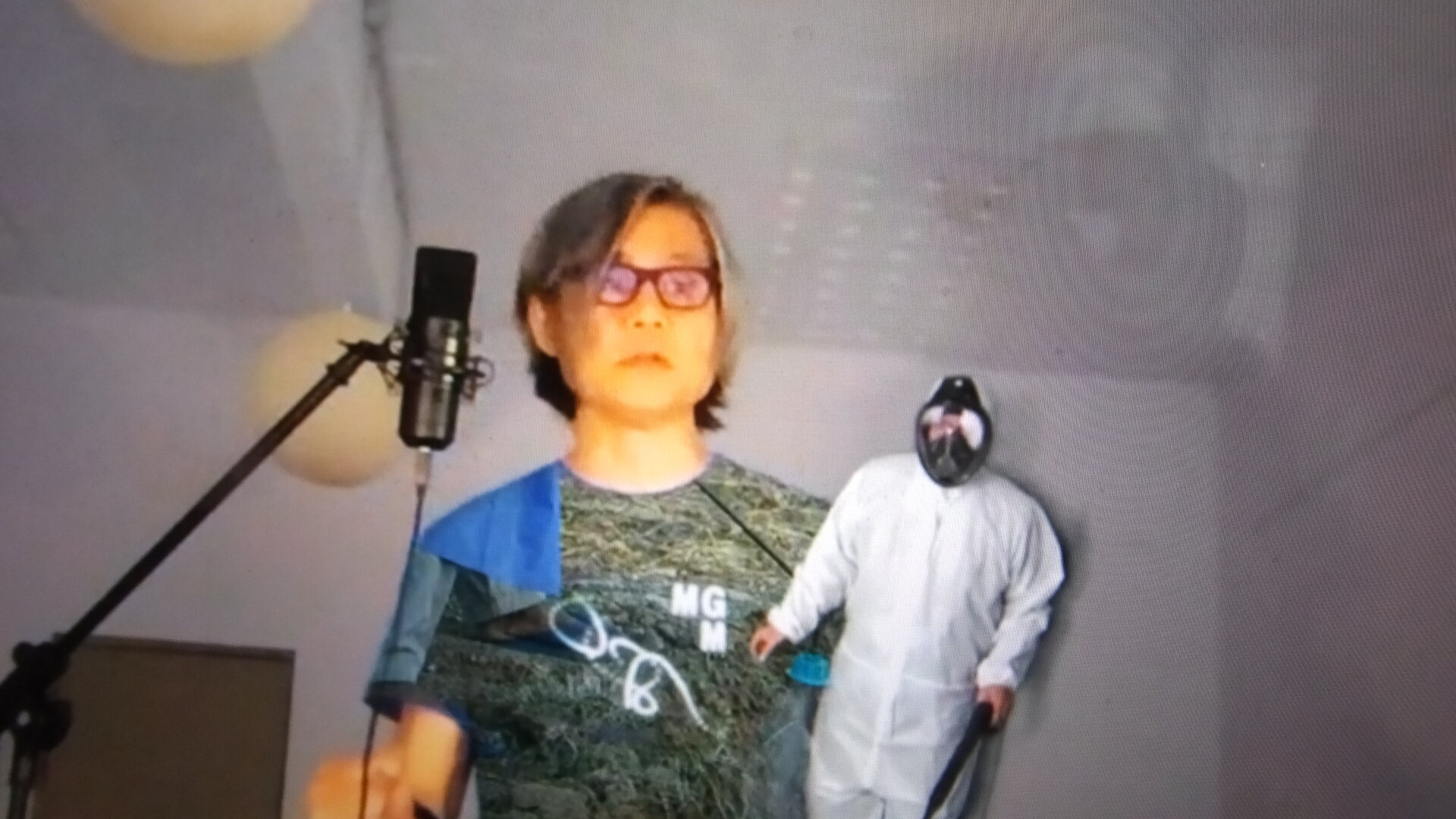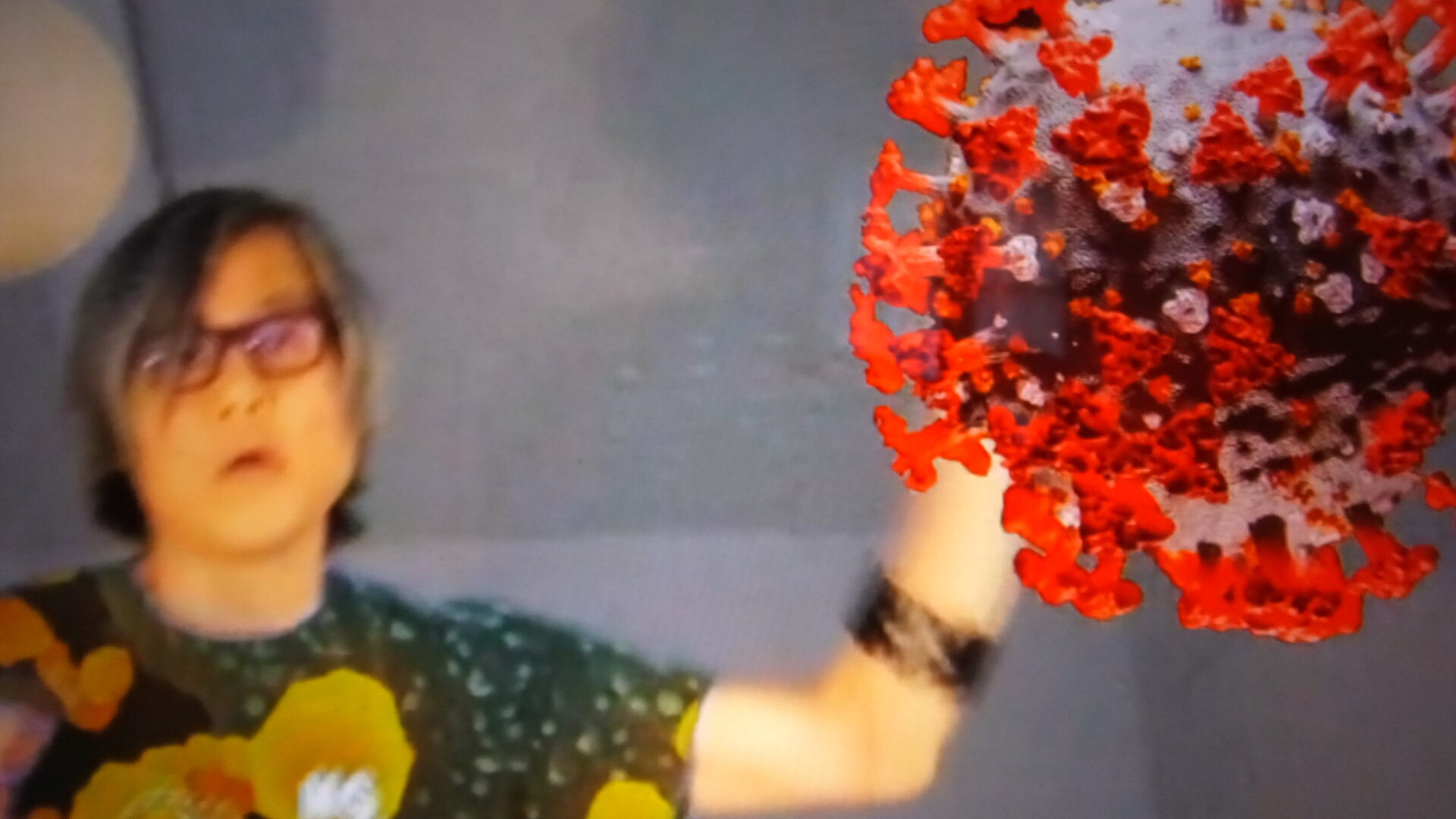Not in the right head space - notes on Deep Third Space - Pandemic Encounters 24 05 2020 (please do it again)
Not in the right head space…
Saturday 23 May 2020
Pandemic Encounters ::: being[ together] in the deep third space
A Networked Performance Installation by Paul Sermon
in collaboration with Randall Packer, Gregory Kuhn & the Third Space Network
(English and French version)
Artists, performers and thinkers who participated: Annie Abrahams (France), Clarissa Ribeiro (Brazil), Roberta Buiani (Canada), Andrew Denton (New Zealand), Tania Fraga (Brazil), Satinder Gill (US), Birgitta Hosea (UK), Charles Lane (US), Ng Wen Lei (Singapore), Marilene Oliver (Canada), Serena Pang (Singapore), Daniel Pinheiro (Portugal), Olga Remneva (Russia), Toni Sant (UK), Rejane Spitz (Brazil), Atau Tanaka (UK)
COVID-19
I have been ill for over two months now and the only time I have left the house, briefly, has been to be hasmatted away to CHU Poitiers COVID 19 Unit. I was really looking forward to this event, as a past London LASER speaker. I am still unwell and being in a unit where I could hear people dying around me, where the nurses and interns, younger than my daughters looked in terror over their masks and tried to open the windows in between newcomers. Where you are shut into the equivalent of a cell – with a huge hazard sign hung on the outside but can still hear people coughing and drowning in their own lungs. You cannot just leave, it is militarized and ritualized totally. This means that every experience or journey to the outside world is magnified and its value increased exponentially.
I have been involved in zoom, skype, YouTube and multi-platform events during the past two weeks, participating in research hubs, book reviews, live interviews, panel discussions and film screenings as well as meditations and ritual work. It has been wonderful, incredible.
The technology is not new but its adaptation, on mass, to link me, include me and develop conversations I would otherwise be ignorant of and excluded from through physical absence has been brilliant : the true democratization of information age that we have been told about, but has never happened – has happened - partially. Of course, you have to be in a position of wealth and privilege enough to have internet connectivity, and then to be in the correct circles, to know where to find the links, the social introductions. The links and password, ritualized access and protocol once in the ‘chatroom’.
If the doors to this truly collaborative method of sharing information swing shut post lockdown, I shall be very disappointed. It will be a deliberate act of exclusion.
Annett (me) watching the live event in recovery (France)
Pandemic Encounters ::: being[ together] in the deep third space
The text for this event read:
“Pandemic Encounters is a networked performance installation inhabited by the live chroma-figure of Paul Sermon. Participants are invited to enter into the deep third space to engage & perform a ritual action as a reflection on the Covid-19 state of being[together] remotely. Each action has its own form: an artistic expression, a scientific analysis, a poetic rendering, a political manifesto, a social critique, a dystopic cry of distress, a subtle movement, a moment of catharsis, or a call in the night from some distant corner of the world. Pandemic Encounters is a collective/creative response to a global pandemic that has triggered an unfolding metamorphosis of the human condition.”
My ears pricked up – not just at the COVID -19 - which is consuming and transforming me currently. But the language. I still cannot physically speak, lack of breath does not allow me and words have become more precious and pertinent, each one has such great weight and import.
I think it was at the 2016 ‘Breaking Convention’ that I noticed that the language in the neuroscientific and related communities was changing. The narratives were suddenly using magical words and references, something which only two years before had been avoided. It was as if we had all suddenly arrived at Hogwarts with quotes from Le Guin and Rumi tripping off everyone’s tongues. Verbs that I had been chided for using (when working with Peterhouse College or interviewing scientists for my research on the intersections between art, science and religion) and which had been rejected vehemently and continually by the scientific community were popping up all over, in public space. Suddenly the language of awe and wonder was very present. It has been very evident the ritual practice of lab and church, as well as scientist and priest, if viewed from a social science or philosophical perspective, fulfill very similar structures and roles; magical implements and robes, special words and glyphs, but from both spaces magical terminology is rejected. The myth of the war between them is not so much about systems of belief but visible performance and control of power (wealth).
In 2018 I had the joy of being part of an online event in Bourges (Fr) with Spideralex and Radio CAArgo where we performed a ritual, live on a server and syncronised radio broadcast, writing fairytale digital applications; cyber feminists and activists all over the world are using ethernet magic to manifest real world events and changes as we speak, on hidden software with obscured platforms. The need for ‘magic’ was evident there and the role of the artist within that, undefined.
In his article published in Makery online yesterday, ‘‘Art as We Don’t Know It’: Against the Unbearable Whiteness of Bioart,’ Rob La Frenais breaks down the use of terms like bioart or sciart as potentially misleading and suggests a very specific set of ontologies are really required to describe arts practice which is informed by science. Yet time and technology wait for no human and the rate of change and obsolescence is very fast.
He writes and quotes; “Oron Catts and Ionat Zurr of SymbioticA rail against the view of art within this new field “Some may say that the inclusion of artists, within the field of synthetic biology for example, served as, if not an explicit promotion of the field, at least as a force of superficial “debate” around the social and biopolitical issues raised through the new technologies that will eventually lead to the domestication of the technology. The artist was traditionally allowed to act as a provocateur or contester, or (to) put it bluntly, in this context, the role of the artist might be like that of a medieval court jester.” They ask: What kind of provocation can an artist make that cannot be utilised or capitalised by other, opposing, propagandist agendas, can make an active and lasting change in society, can make sense of the new-found relationship with matter (in this case life)?”
This term ‘domestication’ of a technology is perhaps what artists do best, they tame it and break it and then put it to use, but it requires, skill, patience, resources and risk-taking (to be labelled a fool). But science, especially contemporary physics which, is essentially an immaterial faith system for ‘normal’ humans, has conceded that it needs help to communicates its laws and gifts to society, to write its mythology. And the links between mythology and ritual are long established (Eliade, Harrison…)
Perhaps a more useful description is that artists always embrace new technologies and writers especially have a role in “writing the future” (Kripal 2010) , Harraway, Braidotti and Jones all agree. So, to see it there – a call to ‘ritual’ in the Leonardo online space was very wonderful thing for me this week – awesome, in religious terms! Definite, intentional, magical terminology in a science art collaboration, or perhaps more correctly termed, ‘performed technology’ based context.
Above : Roberta Buiani (Canada) and the ‘demon’ chatline!
So, as I watched I really did not know what to think or feel.
Perhaps I didn’t know what to expect and should have been more prepared for my own sensitivity. This is a familiar and high profile organization, with fellow artists and practitioners whose work I know and respect. Perhaps it was too soon for me.
(I have been making work around the subject, constantly, drawing and writing on my walls, filling sketchbooks, documenting the hallucinations which are still with me waking and sleeping. My team have been filming, printing, squashing the life out of things which grow in the studio as well as painting, and journaling. We are still on 100%. I do not know if my lungs will every recover their full capacity. I still can speak very little.
I am over stating my personal predicament.
Why?
Because it was the subject of the event.
Because I turned off and dropped out – I exited the ritual
The Art works.
I want to see them again.
I want to know their subtleties again.
The artwork was brilliant and sincere. Poetry and performed text by Abrahams, Ribeiro, Remneva, and Denton, beautiful sounds and images by Oliver which transported me back into safe internal spaces made surreal by low oxygen and high DMT1 levels. It opened with a film by Abrahams (UK)’ of a room where a figure under a blanket with no face struggled for breath – my body responded with fear and tension in the same way as it did to the bare back Daniel Pinheiro. Tanakas human frisson sound and digital performance equally entrancing. It was excellent.
The co-curator and MC of the event, Paul Sermon, awkwardly interacted with the majority of the pieces which were being green screened and skyped in from around the world. The technology was stretched to the maximum and understandably and systematically wayward and this made the whole effect somewhat comical and monty-pythonesque.
This alone, with clumsy and charming sound problems would have been ok – in places – except for the context; ‘COVID’.
The subject, when I was both subject and subject/object literally was too much for me.
Should it be a comi-tragedy?
It felt too jovial. Was I witnessing catharsis? I certainly wasn’t experiencing it.
But why?
From my experience ritual requires certain things, a structure, a script, actors /agents with roles, who follow a prescribed structure, it is about the collective not the individual , and it has a clear intention the outcome of which may be immediate and may not be seen for years. Ritual can be anything from high mass, to cleaning your teeth. Rituals can be frightening, compelling, sexually charged and or joyous and this is why Art, especially performance art and film is so expert art ritual, but rituals have a purpose (and this purpose can be wildness and mayhem too.)
The purpose was clearly stated in the invitation, and most of the intent, if not all was fulfilled. As with the apprehension of language, rituals are honed and made more powerful and efficient with repetition and practice
But, there was an extra element which distracted and disrupted.
Above all else the physical and psychological spaces of ritual are traditionally ‘held’ or ‘contained’, from megaliths to cathedrals the formal containment of physical space and the roles played with in them have been a priority.
Daniel Pinheiro (Portugal)
What, for me, made it uncomfortable, was to be a part of was the timeline, the live chat, which became silly. The audience was largely familiar with each other and naturally pleased and happy for the contact. Excitable and lighthearted, almost celebratory.
I commented twice, once asking if it was (an episode of) the “Goodies’, and found I had to leave before the completion of the event. The chatline seemed (to me) unsafe, inappropriate; it distracted from the work and broke (my perceived )notions of ‘politeness’ and protocol, in their formal senses, which have become normative to such online ‘events’. In all the other events I have attended, the safety of the space and speakers is held or kept safe by the timeline being deactivated, or by other speakers being held on mute, whilst the key actor ‘performs’. I have clearly become accustomed to this, very fast. It is ‘normally’ a very tightly, sometimes overcontrolled space. I wanted it policed! In ritual participants sacrifice individual liberty for the collective. They also have learnt patience and to wait with the technology or tools of the ritual to function. Glitches are to be expected and become private even contemplative pauses.
In the future will the altar be a screen, will you have a ‘ritual’ computer, only used for ceremony and will we an avatar instead of a robe?
The attempts to lead a narrative through the work, connecting it, by Serman would have been hilarious and comic, in another context and some of the most poignant pieces, which had clearly been developed with huge sincerity and deep reflection, were altered in their delivery and reception by the platform.
I started to feel upset.
Paul Serman as the avatar/host/connector in front of work by Toni Sant (UK)
The comments in this live chat feed which at first appeared light hearted and were evidently intended to support performers when the platform glitched and Serman when his tec failed, then took on a life of their own. A ‘demon’ had entered the sacred space!
I felt nauseous and my breathing became difficult. I still cannot laugh either (physically).
I had wanted to stay, but the photograph ; the image of the woman on the ventilator (does her family know her image is in this performance?), with no name (and to my mind probably dead) kept haunting me. Was this a real still, or a staged image? Context is everything. The plague mask intended to represent macabre and carnivalesque was what? I don’t know – a trope – a lazy prop ?– we are not through this plague, those who have had it are not yet ready to perform it; the does ‘does her family know’? woman live, is she/was she someone’s mum? that could have been me by a whisker…
I didn’t and don’t want to sound negative, I wanted to engage.
I worry I am being too negative now, it is the operation of the technology not the work I am critiquing. Partly because I want to see the work, again, uninterrupted, as it was made and to contemplate what on some levels is a devotional act. With another subject, less grave, the light-hearted playful segways clunkily sewn together by Serman’s chroma persona and the interactive, multi-national audience would have made it a wonderful event. For others it may have been.
Perhaps for the majority it was?
For those who have not suffered? Who are not in it, it could be cathartic a release from the weight and fear of the suffering of others?
For me it felt sad, unintentionally disrespectful and suffocating.
The context for the ‘chat’ felt all wrong.
I know this was not the intention
And the works, if left alone by sideline, ‘online heckling’ (my second comment) were as I have said brilliant and sensitive.
Profound and uncontrived, the curation wonderful.
It was successful for me because film, performance and animations are the perfect medium to express the experiences of this plague.
It was not at all what I expected
I did not feel it was a safe space, and that is what I need right now.
I felt that there was a gulf of respect, created solely and separately by the technology, for those with COVID 19, for those suffering deeply because of it and for the work of the artists – created entirely by the presence of an active timeline – not because the chattee’s were badly behaved, just because it distracted and had not been structured or instructed. The power of the word.
I said goodbye before it finished.
I lay on my bed, pain in my lungs and back, Vicks rubbed on my face to help my breath and I was left a little numb.
This meant that I missed the final pieces/performances and missed the analysis of the chat and the feedback from the community. I am sure they addressed some of the issues I raise here – the technology is difficult (but not brand new) the format exciting, lively, experimental and fun – perhaps not so appropriate for this situation.
Perhaps my mind is too fuzzy still and I am feeling angry, dislocated and my usually thin filters have gone to nothing, I was too tired to present any rational critique apart from “I am too tired for this to be fun – it feels as if it trivializes the people in it – is it too soon to be reflecting/reflexing – many more people are going to die – why is everyone enjoying it so much?”.
So, my experience and account of the Pandemic Encounter is not complete – I am not providing a full account – but I am providing an account of someone invested in COVID. A witness.
I go back to the statement of purpose to check and yes “Participants are invited to enter into the deep third space to engage & perform a ritual action as a reflection on the Covid-19 state of being[together] remotely” – this was achieved beautifully.
Marilene Oliver (Canada)
Mircea Eliade asks you to decide between either everything and all spaces or nothing and no spaces being sacred – and the CORONA outbreak highlights access to space, and all space can be sacred, it can also be desacralized. The honing of online performance and unification of disparate international parties is part of our future and we cannot deny it is highly ritualized. We are, I think developing new interactive languages and here the grammar and the syntax needed a little correction! But no doubt so does this text.
Because we entered remotely and there were no instructions; and normally a ritual follows a familiar pattern (in fact familiarity is crucial, like repetition and duplication to ritual – it defines it) we collectively felt for the structure and intuited that there was an order, a sequence of performative experiences, through and over which Serman hosted/performed, although the technology meant that this was a freefall experience.
Serman came across as a lovely soul, and clearly there was a tremendous, nay a HUGE amount of work behind the piece, but the distraction of format made this appear somehow less so.
And the numbers; up to 400, including makers and technicians, many not entirely focused on the glitched performances, but enjoying the interpersonal plays and relational aspects of the group, made this a completely bizarre experience to a dazed viewer – and felt time people rustling their crisp packets and talking loudly in the cinema.
Am I still being too harsh? Yes; in reality had the comments been turned off, had the audience participants participated visually, oral/aurally only at the end, in a post-performance discussion and had we just watched the artists and their work, the impact would have been very different. It would have been stunning. Some of the pieces were sublime and touched me viscerally. Then, I would have been carried on a truly reflective journey, uncomfortable and sorrowful at times, the power of ritual would have been allowed the space to work its magic.
The sacred space being the internet itself (something I believe it desperately needs),
the glitches and pauses, the frustrations and fragmentation would have mirrored the processes and errors of the pandemic in society.
Serman then would have embodied the virus, entering, into an alien paradigm with every host (artist) and affecting the outcome – altering it , disrupting it in an inappropriate and unwanted collaboration
Then it would have been a wonderful and contained set of works
It would have been a positively profound experience for me.
I send out a request now – to Paul Serman, Greg Kuhn, Randall Packer and all the artists involved to please compile a video or film of the event, in sequence, unavatared/chromed; just the work, no audience chatter.
It is a great set of works and fabulously curated.
I would like to be able to watch it as an uninterrupted work, it will truly then be a timeless, ritual piece and carry the potential for the viewer to reflect and provide a deeper third space, for contemplation which the piece so requires and justifies.
I realise I am hypersensitive and one of the ‘COVID possessed’ and that this was the first venture into DEEP THIRD SPACE, and I will definitely be returning (if they will have me). It can become a truly sacred and unifying space to share and develop ideas, languages and technologies of many kinds.
Thank you for being brave and doing the work.
https://www.makery.info/en/2020/05/27/against-the-unbearable-whiteness-of-bioart/?fbclid=IwAR2dAByyMr75evP3XQ8b0sBk6PJudqlvRLYxvJwpRsvIs0hrSTCS80vKVRg
https://randallpacker.com/our-first-plunge-into-the-deep-third-space/?fbclid=IwAR2sxRfVrShAEmyuL9PkIk-RdbjGjlw2_JMS1OdcBUSke3brhjKVuMwKD9Q
http://www.bandits-mages.com/blog/2018/10/03/ondes-sauvages-futurotopies-feministes-r%e2%88%86%e2%88%86dio-c%e2%88%86%e2%88%86rgo-bandits-mages-12-16-novembre-2018-bourges/
Kripal.J. 2010 Authors of the Impossible : The Paranormal and the Sacred . University of Chicago Press
Pas dans le bon espace de tête...
Samedi 23 mai 2020
Rencontres pandémiques :: : être [ensemble] dans le troisième espace profond
Une installation de performance en réseau par Paul Sermon
en collaboration avec Randall Packer, Gregory Kuhn et le troisième réseau spatial
Les artistes, les interprètes et les penseurs qui ont participé : Annie Abrahams (France), Clarissa Ribeiro (Brésil), Roberta Buiani (Canada), Andrew Denton (Nouvelle-Zélande), Bhavani Esapathi (Royaume-Uni), Tania Fraga (Brésil), Satinder Gill (États-Unis), Birgitta Hosea (Royaume-Uni), Charles Lane (États-Unis), Ng Wen Lei (Singapour), Marilene Oliver (Canada), Serena Pang (Singapour), Daniel Pinheiro (Portugal), Olga Remneva (Russie), Toni Sant (Royaume-Uni), Rejane Spitz (Brésil), Atau Tanaka (Royaume-Uni)
COVID-19
Je suis malade depuis plus de deux mois maintenant et la seule fois où j'ai quitté la maison, brièvement, c'est pour me rendre au CHU de Poitiers, unité COVID 19. J'attendais vraiment cet événement avec impatience, en tant qu'ancien intervenant du LASER de Londres. Je suis toujours malade et je me trouve dans une unité où je pouvais entendre des gens mourir autour de moi, où les infirmières et les internes, plus jeunes que mes filles, regardaient avec terreur par-dessus leurs masques et essayaient d'ouvrir les fenêtres entre les nouveaux arrivants. On est enfermé dans l'équivalent d'une cellule - avec un énorme panneau de danger accroché à l'extérieur, mais on peut encore entendre des gens tousser et se noyer dans leurs propres poumons. Vous ne pouvez pas simplement partir, c'est totalement militarisé et ritualisé. Cela signifie que chaque expérience ou voyage vers le monde extérieur est amplifié et que sa valeur augmente de manière exponentielle.
Au cours des deux dernières semaines, j'ai participé à des événements zoom, skype, YouTube et multi-plateformes. J'ai pris part à des centres de recherche, des critiques de livres, des interviews en direct, des discussions de groupe et des projections de films, ainsi qu'à des méditations et des travaux rituels. Ce fut merveilleux, incroyable.
La technologie n'est pas nouvelle mais son adaptation, en masse, pour me relier, m'inclure et développer des conversations que j'aurais autrement ignorées et dont je serais exclu par mon absence physique a été brillante : la véritable démocratisation de l'ère de l'information dont on nous a parlé, mais qui ne s'est jamais produite - s'est produite - partiellement. Bien sûr, il faut être dans une position de richesse et de privilège suffisante pour avoir une connexion Internet, et ensuite être dans les bons cercles, savoir où trouver les liens, les introductions sociales. Les liens et le mot de passe, l'accès ritualisé et le protocole une fois dans le "chatroom".
Si les portes de cette méthode véritablement collaborative de partage d'informations se ferment, je serai très déçu. Ce sera un acte d'exclusion délibéré.
Pandemic Encounters :: : être [ensemble] dans le troisième espace profond
Le texte de cet événement a été lu :
"Pandemic Encounters" est une installation de performance en réseau habitée par la figure chromatique vivante de Paul Sermon. Les participants sont invités à entrer dans le troisième espace profond pour engager et exécuter une action rituelle comme une réflexion sur l'état d'être [ensemble] à distance de Covid-19. Chaque action a sa propre forme : une expression artistique, une analyse scientifique, une interprétation poétique, un manifeste politique, une critique sociale, un cri de détresse dystopique, un mouvement subtil, un moment de catharsis, ou un appel dans la nuit provenant d'un coin éloigné du monde. Pandemic Encounters est une réponse collective/créative à une pandémie mondiale qui a déclenché une métamorphose de la condition humaine".
Mes oreilles se sont dressées - pas seulement au COVID -19 qui me consomme et me transforme actuellement. Mais la langue. Je ne peux toujours pas parler physiquement, le manque de souffle ne me le permet pas et les mots sont devenus plus précieux et plus pertinents, chacun d'eux ayant un poids et une importance si importants.
Je pense que c'est lors de la "Breaking Convention" de 2016 que j'ai remarqué que le langage dans les communautés neuroscientifiques et connexes était en train de changer. Les récits utilisaient soudain des mots et des références magiques, ce qui avait été évité seulement deux ans auparavant. C'était comme si nous étions tous soudainement arrivés à Poudlard avec des citations de Le Guin et Rumi qui faisaient parler tout le monde. Les verbes que l'on m'avait reproché d'utiliser (lors de mon travail au Peterhouse College ou lors d'entretiens avec des scientifiques pour mes recherches sur les intersections entre l'art, la science et la religion) et qui avaient été rejetés avec véhémence et de façon continue par la communauté scientifique surgissaient partout, dans l'espace public. Soudain, le langage de l'émerveillement et de l'émerveillement était très présent. Il est apparu très clairement que la pratique rituelle du laboratoire et de l'église, ainsi que celle du scientifique et du prêtre, si on les considère sous l'angle des sciences sociales ou de la philosophie, remplissent des structures et des rôles très similaires, des instruments et des vêtements magiques, des mots spéciaux et des glyphes, mais dans les deux espaces, la terminologie magique est rejetée. Le mythe de la guerre entre eux ne concerne pas tant les systèmes de croyance que les performances visibles et le contrôle du pouvoir (la richesse).
En 2018, j'ai eu la joie de participer à un rituel en ligne à Bourges avec Spideralex et Radio CAArgo où nous avons effectué un rituel, en direct sur un serveur et une émission de radio synchronisée, en écrivant des applications numériques féeriques ; les cyberféministes et les activistes du monde entier utilisent la magie d'ethernet pour manifester des événements et des changements réels au moment où nous parlons, sur des logiciels cachés avec des plateformes obscures.
Dans son article publié hier dans Makery online, "L'art tel que nous ne le connaissons pas" : Against the Unbearable Whiteness of Bioart", Rob La Frenais analyse l'utilisation de termes comme bioart ou sciart comme potentiellement trompeurs et suggère qu'un ensemble très spécifique d'ontologies est réellement nécessaire pour décrire la pratique artistique qui est informée par la science. Pourtant, le temps et la technologie n'attendent aucun humain et le rythme des changements et de l'obsolescence est très rapide.
Il écrit en citant : "" Oron Catts et Ionat Zurr de SymbioticA s'insurgent contre la vision de l'art dans ce nouveau domaine "Certains diront que l'inclusion des artistes, dans le domaine de la biologie synthétique par exemple, a servi, sinon de promotion explicite du domaine, du moins de force de "débat" superficiel autour des questions sociales et biopolitiques soulevées par les nouvelles technologies qui conduiront finalement à la domestication de la technologie. L'artiste était traditionnellement autorisé à agir comme un provocateur ou un contestataire, ou pour le dire crûment, dans ce contexte, le rôle de l'artiste pourrait être comme celui d'un bouffon de cour médiéval". Ils demandent : "Quel genre de provocation peut faire un artiste qui ne peut être utilisé ou capitalisé par d'autres programmes propagandistes opposés, qui peut apporter un changement actif et durable dans la société, qui peut donner un sens à la nouvelle relation avec la matière (dans ce cas la vie) ?
Ce terme de "domestication" d'une technologie est peut-être ce que les artistes font le mieux, ils l'apprivoisent et la cassent, puis l'utilisent, mais cela demande de l'habileté, de la patience, des ressources et une prise de risque (pour être qualifié d'idiot). Mais la science, en particulier la physique contemporaine qui est essentiellement un système de croyance immatériel pour les humains "normaux", a concédé qu'elle a besoin d'aide pour communiquer ses lois et ses dons à la société, pour écrire sa mythologie. Et les liens entre la mythologie et les rituels sont établis depuis longtemps (Eliade, Harrison...). Une description plus utile est peut-être que les artistes adoptent toujours les nouvelles technologies et que les écrivains, en particulier, ont un rôle à jouer dans "l'écriture du futur" (Kripal 2010), Harraway, Braidotti et Jones sont tous d'accord. Donc, le voir là - un appel au "rituel" dans l'espace en ligne Leonardo - était une chose merveilleuse pour moi cette semaine - génial, en termes religieux ! Une terminologie précise, intentionnelle et magique dans un contexte de collaboration science-art, ou peut-être plus exactement dans un contexte basé sur la "technologie exécutée".
Donc, en regardant, je ne savais vraiment pas quoi penser ou ressentir.
Peut-être que je ne savais pas à quoi m'attendre et que j'aurais dû être mieux préparé à ma propre sensibilité. C'est une organisation familière et très en vue, avec des collègues artistes et praticiens dont je connais et respecte le travail. Peut-être était-il trop tôt pour moi.
J'ai travaillé sur le sujet, constamment, en dessinant et en écrivant sur mes murs, en remplissant des carnets de croquis, en documentant les hallucinations qui m'accompagnent encore dans mon sommeil et mon éveil. Mon équipe a filmé, imprimé, écrasé la vie des choses qui poussent dans l'atelier, ainsi que la peinture et le journal intime. Nous sommes toujours à 100%. Je ne sais pas si mes poumons vont tous retrouver leur pleine capacité. Je ne peux encore que très peu parler.
J'en ai trop dit sur ma situation personnelle.
Pourquoi ?
Parce que c'était le sujet de l'événement.
Parce que je me suis éteinte et que j'ai abandonné - je suis sortie du rituel
L'art fonctionne.
Je veux les revoir.
Je veux connaître à nouveau leurs subtilités.
L'œuvre d'art était brillante et sincère. De la poésie et des textes interprétés par Abrahams, Ribeiro, Remneva et Denton, de beaux sons et images d'Oliver qui m'ont transporté dans des espaces intérieurs sûrs rendus surréalistes par un faible taux d'oxygène et un taux élevé de DMT1. Le spectacle s'est ouvert sur un film d'Abrahams (UK)" d'une pièce où une silhouette sous une couverture sans visage luttait pour respirer - mon corps réagissait avec peur et tension de la même manière qu'il le faisait avec le dos nu de Daniel Pinheiro. Tanakas, son frisson humain et performance numérique tout aussi envoûtante. C'était excellent.
Le co-commissaire et MC de l'événement, Paul Sermon, a maladroitement interagi avec la majorité des morceaux qui étaient projetés en vert et écoutés du monde entier. La technologie a été utilisée au maximum et de manière compréhensible et systématique, ce qui a rendu l'effet quelque peu comique et monty-pythoniste.
Rien que cela, avec des problèmes sonores maladroits et charmants, aurait été acceptable - par endroits - sauf pour le contexte : "COVID".
Le sujet, quand j'étais à la fois sujet et sujet/objet, était littéralement trop pour moi.
Devrait-il s'agir d'une comi-tragédie ?
C'était trop jovial. Étais-je témoin d'une catharsis ? Je n'en faisais certainement pas l'expérience.
Mais pourquoi ?
D'après mon expérience, le rituel nécessite certaines choses, une structure, un scénario, des acteurs / agents avec des rôles, qui suivent une structure prescrite, il s'agit du collectif et non de l'individu, et il a une intention claire dont le résultat peut être immédiat et ne pas être vu avant des années. Le rituel peut être n'importe quoi, de la grande masse au nettoyage des dents. C'est pourquoi l'art, en particulier les arts du spectacle et le cinéma, est un rituel artistique si expert, mais les rituels ont un but (et ce but peut être la sauvagerie et le chaos).
L'objectif était clairement énoncé dans l'invitation, et la plupart des intentions, sinon toutes, ont été satisfaites. Comme pour l'appréhension du langage, les rituels sont affinés et rendus plus puissants et efficaces par la répétition et la pratique
Mais, il y avait un élément supplémentaire qui distrayait et perturbait.
Par-dessus tout, les espaces physiques et psychologiques du rituel sont traditionnellement "tenus" ou "contenus", des mégalithes aux cathédrales : le confinement formel de l'espace physique et les rôles qui y sont joués ont été une priorité.
Ce qui, pour moi, rendait la situation inconfortable, c'était de faire partie de la ligne de temps, du chat en direct, qui est devenu idiot. Le public se connaissait bien et était naturellement heureux de ce contact. J'ai commenté deux fois, une fois en demandant si c'était (un épisode des) "Goodies", et j'ai découvert que je devais partir avant la fin de l'événement. La ligne de discussion m'a semblé peu sûre et inappropriée ; elle a détourné l'attention du travail et a brisé les notions de "politesse" et de protocole, dans leur sens formel, qui sont devenues normatives pour de tels "événements" en ligne. Dans tous les autres événements auxquels j'ai participé, la sécurité de l'espace et des orateurs est assurée ou maintenue par la désactivation de la ligne de temps ou par le fait que les autres orateurs sont tenus en silence, tandis que l'acteur principal "joue". Je me suis clairement habitué à cela, très rapidement. Il s'agit "normalement" d'un espace très étroit, parfois surcontrôlé. Je voulais qu'il soit contrôlé ! Dans le rituel, les participants sacrifient la liberté individuelle pour le collectif. Ils ont également appris à être patients et à attendre avec la technologie ou les outils du rituel pour fonctionner. Dans le futur, l'autel sera-t-il un écran, aura-t-on un ordinateur "rituel", utilisé uniquement pour la cérémonie, et aurons-nous un avatar au lieu d'une robe ? Les tentatives de Serman de mener une narration à travers l'œuvre, en la reliant, auraient été hilarantes et comiques, dans un autre contexte et certaines des pièces les plus poignantes, qui avaient clairement été développées avec une énorme sincérité et une profonde réflexion, ont été altérées dans leur livraison et leur réception par la plateforme.
Les commentaires de ce flux de discussion en direct qui, au début, semblaient légers et visiblement destinés à soutenir les interprètes lorsque la plateforme a connu des problèmes et que Serman, lorsque son système technique a échoué, a pris sa propre vie. Un "démon" était entré dans l'espace sacré !
J'ai eu la nausée et ma respiration est devenue difficile. Je n'arrive toujours pas à rire non plus (physiquement).
J'avais voulu rester, mais la photographie ; l'image de la femme sur le ventilateur (sa famille sait-elle que son image est dans cette représentation ?), sans nom, (et à mon avis probablement morte) continuait de me hanter. Était-ce une vraie photo ou une image mise en scène ? Le contexte, c'est tout. Le masque de la peste destiné à représenter le macabre et le carnavalesque était quoi ? Je ne sais pas - un trope - un accessoire paresseux ? nous ne sommes pas encore débarrassés de cette peste, ceux qui l'ont eue ne sont pas encore prêts à la pratiquer ; la femme "sa famille le sait-elle" ? vit, est-elle/était-elle la mère de quelqu'un ? cela aurait pu être moi d'un seul coup...
Je ne voulais pas avoir l'air négatif, je voulais m'engager.
J'ai peur d'être trop négatif maintenant, c'est le fonctionnement de la technologie et non le travail que je critique. En partie parce que je veux voir l'œuvre, encore une fois, ininterrompue, telle qu'elle a été réalisée et envisager ce qui, à certains niveaux, est un acte de dévotion.
Avec un autre sujet, moins grave, les segways enjoués et enjoués, cousus ensemble par le personnage chromatique de Serman, et le public interactif et multinational en auraient fait un événement merveilleux. Pour d'autres, cela aurait pu être le cas.
Peut-être pour la majorité ?
Pour ceux qui n'ont pas souffert ? Pour ceux qui n'en font pas partie, cela pourrait être une libération cathartique ?
Pour moi, c'était triste, involontairement irrespectueux et étouffant.
Le contexte de la "discussion" n'était pas du tout le bon
Je sais que ce n'était pas l'intention
Et les œuvres, si on les laissait tranquilles grâce aux clowneries et à la ligne de touche, le "chahut en ligne" (mon deuxième commentaire) était, comme je l'ai dit, brillant et sensible.
Profond et sans artifice, la cure est merveilleuse.
Elle a été un succès pour moi car le film, la performance et les animations sont le moyen parfait pour exprimer les expériences de ce fléau.
Ce n'était pas du tout ce à quoi je m'attendais
Je n'avais pas le sentiment que c'était un espace sûr, et c'est ce dont j'ai besoin en ce moment.
Je sentais qu'il y avait un fossé de respect, créé uniquement et séparément par la technologie, pour ceux qui avaient COVID 19, pour ceux qui en souffraient profondément et pour le travail des artistes - créé entièrement par la présence d'une ligne de temps active - non pas parce que les bavards se comportaient mal, mais simplement parce qu'ils étaient distraits et n'avaient pas été structurés ou instruits. Le pouvoir de la parole.
Je lui ai dit au revoir avant qu'il ne soit terminé.
Je me suis couché sur mon lit, j'avais mal aux poumons et au dos, Vicks m'a frotté le visage pour m'aider à respirer et je suis resté un peu engourdi.
Cela signifie que j'ai manqué les dernières pièces/performances et que j'ai raté l'analyse du chat et les réactions de la communauté. Je suis sûr qu'ils ont répondu à certaines des questions que je soulève ici - la technologie est difficile (mais pas nouvelle) ; le format est passionnant, vivant, expérimental et amusant - peut-être pas si approprié dans cette situation.
Peut-être que mon esprit est encore trop flou et que je me sens en colère, disloqué et que mes filtres habituellement minces n'ont rien donné, j'étais trop fatigué pour présenter une critique rationnelle autre que "je suis trop fatigué pour que ce soit amusant - j'ai l'impression que cela banalise les gens qui s'y trouvent - il est trop tôt pour réfléchir - beaucoup plus de gens vont mourir - pourquoi tout le monde s'amuse autant ?
Ainsi, mon expérience et mon récit de la rencontre sur la pandémie ne sont pas complets - je ne fournis pas un récit complet - mais je fournis le récit de quelqu'un qui a investi dans COVID. Un témoin.
Je reviens à la déclaration d'intention pour vérifier et oui "Les participants sont invités à entrer dans le troisième espace profond pour s'engager & effectuer une action rituelle comme réflexion sur l'état d'être Covid-19 [ensemble] à distance" - cela a été réalisé de manière magnifique.
Mircea Eliade vous demande de choisir entre tout et tous les espaces ou rien et aucun espace n'étant sacré - et l'épidémie de CORONA met en évidence l'accès à l'espace, et tout espace peut être sacré, il peut aussi être désacralisé. Le perfectionnement des performances en ligne et l'unification de partis internationaux disparates font partie de notre avenir et nous ne pouvons pas nier qu'il est hautement ritualisé. Nous sommes, je pense, en train de développer de nouveaux langages interactifs et ici la grammaire et la syntaxe avaient besoin d'une petite correction !
Comme nous sommes entrés à distance et qu'il n'y avait pas d'instructions, et que normalement un rituel suit un schéma familier (en fait, la familiarité est cruciale, comme la répétition et la duplication d'un rituel - elle le définit), nous avons collectivement ressenti la structure et avons eu l'intuition qu'il y avait un ordre, une séquence d'expériences performatives, par et sur lesquelles Serman a hébergé/performé, bien que la technologie ait fait de cette expérience une chute libre
Serman est apparu comme une âme charmante, et il est clair qu'il y avait un travail énorme, une énorme quantité de travail derrière le morceau, mais la distraction du format a fait que cela semblait moins évident.
Et les chiffres, jusqu'à 400, y compris les réalisateurs et les techniciens, dont beaucoup ne se sont pas entièrement concentrés sur les performances ratées, mais ont apprécié les jeux interpersonnels et les aspects relationnels du groupe, ont fait de cette expérience une expérience complètement bizarre pour un spectateur étourdi - et ont senti le temps que les gens bruissent leurs paquets croustillants et parlent fort au cinéma.
Suis-je encore trop sévère ? Oui ; en réalité, si les commentaires avaient été éteints, si les participants du public n'avaient participé visuellement, oralement ou culturellement qu'à la fin, dans une discussion post-performance et si nous avions simplement regardé les artistes et leur travail, l'impact aurait été très différent. Cela aurait été stupéfiant. Certaines des pièces étaient sublimes et m'ont touché viscéralement. Ensuite, j'aurais été transporté dans un véritable voyage de réflexion, parfois inconfortable et douloureux, le pouvoir du rituel aurait permis à l'espace d'opérer sa magie.
L'espace sacré étant l'internet lui-même (ce dont je crois qu'il a désespérément besoin),
les pépins et les pauses, les frustrations et la fragmentation auraient reflété les processus et les erreurs de la société pandémique
Serman aurait alors incarné le virus, entrant dans un paradigme étranger avec chaque hôte (artiste) et affectant le résultat - le modifiant, le perturbant dans une collaboration inappropriée et non désirée
Il aurait alors constitué un ensemble d'œuvres merveilleuses et contenues
Cela aurait été une expérience sacrée pour moi
J'envoie une demande maintenant - à Paul Serman, Greg Kuhn, Randall Packer et à tous les artistes impliqués - pour qu'ils compilent une vidéo ou un film de l'événement, dans l'ordre, sans données ni chromes ; juste l'œuvre, pas de bavardage du public.
Il s'agit d'un grand ensemble d'œuvres et d'un commissariat fabuleux
J'aimerais pouvoir la regarder comme un ensemble ininterrompu d'œuvres, elle sera alors vraiment une pièce rituelle et intemporelle et portera le potentiel pour le spectateur à réfléchir et à fournir un troisième espace plus profond, pour la contemplation que la pièce exige et justifie ainsi.
C'était la première fois que je m'aventurais dans le DEEP THIRD SPACE, et j'y retournerai certainement (si on m'y invite). Il peut devenir un espace véritablement sacré et unificateur pour partager et développer des idées, des langues et des technologies de toutes sortes.
Merci d'avoir été courageux et d'avoir fait ce travail.
https://www.makery.info/en/2020/05/27/against-the-unbearable-whiteness-of-bioart/?fbclid=IwAR2dAByyMr75evP3XQ8b0sBk6PJudqlvRLYxvJwpRsvIs0hrSTCS80vKVRg
https://randallpacker.com/our-first-plunge-into-the-deep-third-space/?fbclid=IwAR2sxRfVrShAEmyuL9PkIk-RdbjGjlw2_JMS1OdcBUSke3brhjKVuMwKD9Q
http://www.bandits-mages.com/blog/2018/10/03/ondes-sauvages-futurotopies-feministes-r%e2%88%86%e2%88%86dio-c%e2%88%86%e2%88%86rgo-bandits-mages-12-16-novembre-2018-bourges/
Kripal.J. 2010 Les auteurs de l'impossible : le paranormal et le sacré . University of Chicago Press
Traduit avec www.DeepL.com/Translator (version gratuite)


